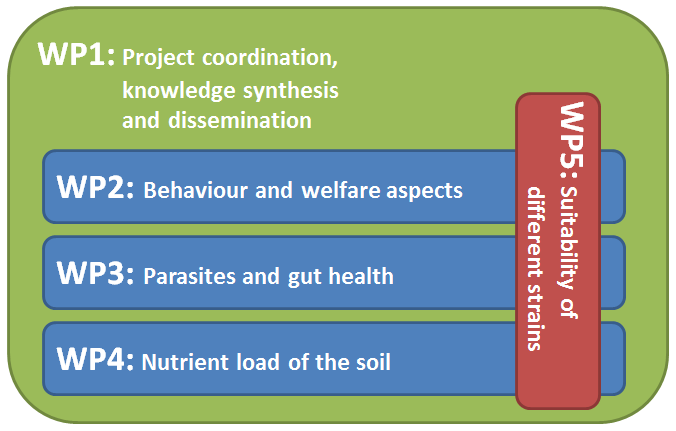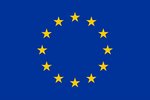Work packages
WP1 Project coordination, knowledge synthesis and dissemination
Within this WP the overall project will be coordinated and the specific objectives of this WP are to ensure effective internal and external project communication. The purpose is to make sure the work in the various WPs is linked to each other for efficient use of resources.
There will be a coordination of the training in scoring, and other necessary calibrations of methodology will be performed.
provide overview to project implementation and monitoring progress and quality. Furthermore, WP1 is organizing meetings (physical and video meetings) within the project group and with the reference group of stakeholders.
WP2 Behaviour and welfare aspects
Although there is evidence that outdoor ranging promotes natural behaviour and welfare in poultry, the mechanisms behind the positive effects of the free range are not fully understood. Our understanding has been hampered by our inability to track birds individually and link the free range use of individual birds to other behaviour and welfare traits. Individual traits like fearfulness, plumage and body condition and keel bone damage may have strong relationships with individual free range use.
A novel method of ultra-wideband tracking now allows us to track individual hens continuously in the free range. This allows us to investigate how free range use influences behaviour and welfare of individual laying hens. We hypothesize that birds that make frequent use of the free range are less fearful, have a better plumage condition and a lower incidence of keel bone damage than birds that make little use of the free range or stay close to the house. Furthermore, we will investigate how early-life conditions and structure of the free range affect individual range use. Here, we hypothesize that birds reared with dark brooders during early-life will have a more frequent free range use and that a high degree of free range cover will attract more birds than areas providing less cover to the birds.
The experimental work will take place in an existing experimental set-up in Belgium. Hens will be observed from 17 to 60 weeks of age. At the beginning, middle and end of the laying period, all birds will be assessed with a detailed welfare protocol: keel bone damage, leg problems, plumage condition, skin condition, fearfulness, comb condition and colour and observable health problems will all be assessed. The experimental field is equipped with cutting-edge technology for tracking the location of individual hens in the free range automatically. Because of the individual tracking, we will have unique data on use of specific areas of the free range.
The expected results are to achieve:
- Understanding how free range use influences behaviour and welfare of individual laying hens
- Knowledge on the potential of dark brooders to increase free range use
- Knowledge on the preferences of laying hens regarding free range
- Detailed knowledge on the effects of external factors on individual free range in laying hens
This work will provide useful knowledge for commercial practice on 1) optimal design of the free range and 2) effects of free range use on behaviour and welfare. If positive effects of frequent use of the range on plumage condition and keel bone damage are found, this can be an incentive for commercial farmers to invest in making their free range area more attractive and thereby improve both their economic results (reduced mortality) and the laying hen welfare.
WP 3 Parasites and gut health
Organic egg production farms, especially farms with fixed stables that are already keeping chickens outdoors on the same ranging areas for more than 10 years, face an increased parasite load by parasites that have become resistant to anthelmintics, making the free range a risk factor. At the same time, it has been found that in an epidemiological study including 55 organic egg production farms in eight European countries, showed that the free range may be a potential solution in reducing worm infections. The earlier on the day the hens had access to the free range area, the fewer eggs of Ascaridia galli were found in their gastro-intestinal tract. Furthermore it has been found that there is a lower risk for worm infestations in relation to higher use of the free range. The results of the latter both studies may be explained by the fact that if more faeces are excreted outside, the infected faeces are spread over a larger area, somehow resulting in decreasing risk to come into contact with infected manure. Furthermore, using the free range may have a positive effect on gut health and digestion. Depending on genotypes and husbandry system, the microbial population and physical features of the gastrointestinal tract may change. In this WP we would like to further explore the relation between range use and worm infections in organic laying hens and between range use and gut health in organic broilers.
The research questions are mainly:
- Is there a relation between parasite eggs (Ascaridia and Heterakis) in the free range soil and the intensity of use of the range area in terms of distance to the stable and proportion of chickens using the range area?
- Is there a relation, on the level of individual laying hens, between frequency of use of the range area and faecal egg counts?
- Is there a relation, on the level of individual broilers, between frequency of use of the range area and gut health and digestive efficiency?
The questions concerning parasites in laying hens will be investigated on 10 commercial farms in each country (IT, NL and SE) and on an experimental site in Belgium (see WP2).
Soil samples will be taken from the free range soil at different distances from the house. The health management of the farm will be described in terms of terms of use of anthelmintics yes/no, type of anthelmintics, and frequency of anthelmintic treatments. Multivariate models will be used to identify relations between the prevalence of parasite eggs in the soil on the one hand and features of the sample location, the range management, health management on the other hand.
Individual droppings will be collected for faecal egg counts both outside at a distance of at least 20 meters from the pop-holes and inside the building. Differences between outdoor and indoor individuals will be analysed.
WP 4 Nutrient load of the soil
In organic hen husbandry, excretion of Nitrogen and Phosphorous in the outdoor run generally far exceeds the uptake by vegetation. Especially in organic farming, reduction of loss of N and P from the production cycle is important, because the use of artificial fertilisers is prohibited. Vegetation growth, especially in parts of the outdoor run with a high hen density, is very limited due to the intensive foraging. The distribution of birds on the range is rarely even and may lead to overuse of pasture near the house, reducing potential foraging opportunities and increasing concentrations of parasites in certain areas. additionally the accumulation of phosphorus and nitrogen in the soil poses a hazard to the environment.
The aim of this work package is to evaluate which free range design stimulates more optimal use by the hens, thereby reducing the environmental problems and the waste of nutrients in the soil of ranging areas around the house. The WP will be developed in IT in commercial farms and in Belgium in the experimental facility with mobile houses (see WP2). In IT visits to three farms implementing best practices aimed to encourage and promote bird’s access to free-range areas are scheduled twice at the beginning and at the end of a production cycle. In each range area the vegetation cover will be assessed and samples of the soil will be taken at different depths for analyses of nutrient load, i.e. mineral nitrogen and phosphorus, as well as parasite eggs. The experimental site in BE will allow to measure the nutrient load related to ranging behaviour in parts of the free-range planted with short-rotation coppice willows and hazelnut trees. The use of free range will be monitored on individual birds, allowing identifying hot spots in the free range where effects on soil nutrients will be studied.
The soil analyses on each farm will comprise representative samples of the soil that will be extracted at two different depths. Soil samples will be analysed regarding texture, pH, conductivity, organic matter, cationic exchange capacity, total nitrogen, nitrates, phosphorus, potassium, calcium carbonate. During each visit, the number and location of the hens on the range and/or in the covered veranda will be recorded three times per day. Behavioural observation will be performed in the commercial farms by counting the number of hens in the three selected areas. In the same areas both soil and manure samples will be collected in order to evaluate the parasitic load of the free range according to the presence of animals. Thus, the sampling and analysis will be performed in close collaboration with WP 3.
The expected result of WP4 is that more knowledge and understanding of the management of the free range and the effects on range use and nutrient load will be generated. This will help farmers to develop more successful husbandry practices and therefore obtain better results.
WP5 Suitability of different strains of broilers and laying hens
Studies comparing conventional and organic production using conventional high-performance strains of both layers and broiler chickens show that productivity and welfare can be decreased in the organic system. Issues in organic broiler and layer production include increased morbidity (e.g. footpad dermatitis), lower efficiency in feed conversion ratio and increased mortality, due to e.g. injurious pecking and predation. In order to mitigate the welfare problems, as well as decreased yield, alternative genotypes, such as robust native strains bred specifically for organic systems should be evaluated.
Within the project, alternative genotypes for meat and egg production will be evaluated using a range of welfare indicators: behaviour (e.g. range use and feather pecking), health (keel bone damage, foot disorders, bone strength, gait score, damage to plumage and skin, mortality, etc.), affective states (fearfulness) and production (different egg parameters, feed consumption, feed conversion ratio, etc.).
Traditional and automatic precision-farming data recording methods combined with transect-based methods for broilers, as well as the well-defined welfare assessment protocol for laying hens developed in our former EU CoreOrganic project (“Healthy Hens”) will be applied to measure the different welfare indicators. The studies will be performed using both experimental facilities in DK, PL and TR and in SE in commercial farms that are using slower growing strains, always following current EC organic regulations. Studies will look into both individual and breed differences. The breeds used will be a heritage meat chicken strain (PL), bred specifically for the present project, local (national) breeds (TR) and commercially available strains adapted for organic systems (TR, DK and SE).
Comparison of welfare, as indicated by behaviour, health, affective states and production, of different genotypes can be used directly by producers to choose the most suitable breed available. Knowledge on the link between the different welfare indicators (e.g. health and range use) on individual level is valuable information useable in breeding programs to select for more suitable strains for organic farming. Implementation of the results from WP5 may therefore improve both bird welfare as well as farmer production economy.

Figure 1. The schematic design of integration and interaction of the specific WPs.
